ASRock's High-End Vision 3D HTPC Reviewed
by Ganesh T S on October 3, 2010 10:20 AM EST
The Vision 3D is basically a notebook solution at its core. It wouldn't make sense to compare it with full blown Clarkdale HTPCs (or for that matter, any system with a power consumption of more than 100W). In the comparative benchmarks provided in the rest of this review, we will provide the scores obtained by the Vision 3D and other notebook solutions. Prior to those, let us look at some of the specific features of the Vision 3D.
USB 3.0 Performance
In the Core 100 review, we had pointed out the fact that the H55M chipset does not provide support for full USB 3.0 performance without a PLX bridge chip. As the Vision 3D caters to the high end market, it would have made sense for ASRock to incorporate this into the motherboard. Unfortunately, they decided to increase the number of USB 3.0 ports instead of aiming to obtain full performance from the pair of ports provided by the NEC controller.
We hooked up OCZ's Enyo 128 GB USB 3.0 external SSD (which has received glowing reviews everywhere with upto 200 MBps read and 190 MBps write speeds) to the various USB 2.0 / 3.0 ports of the Vision 3D (and also repeated the tests with the Core 100).
The OCZ Enyo on the Fresco Logic USB 3.0 Port of the Vision 3D
Using the Random Access feature of HD Tune Pro 4.50, we obtained the average read and write speeds for random sized accesses to random locations on the SSD. The performance metrics are graphed below. Note that the entries against the USB 3.0 ports of the Core 100 differ from those in the Core 100 review, because those were maximum transfer rates as opposed to the average rate presented here.
Click to enlarge
At the outset, it is clear that the USB 3.0 performance improves when compared with the Core 100. This is probably due to the faster i3-370M CPU. An additional interesting observation is that the read and write performance are very similar for the Fresco Logic port. The NEC ports excel at providing read bandwidth, but lose out to Fresco Logic on the write side. Despite these performance numbers, we feel that the third USB 3.0 port is an overkill for the Vision 3D. ASRock could have used the cost premium of this feature towards something more attractive for HTPC users like a SSD boot drive for the OS.
Windows Experience Index
The Core 100's Windows Experience Index was bottlenecked by the Arrandale iGPU. With that going out of the picture, what can hold back the performance of the Vision 3D? Let us look at the Windows Experience Index to get a general feel of the performance that a user can expect out of the machine.
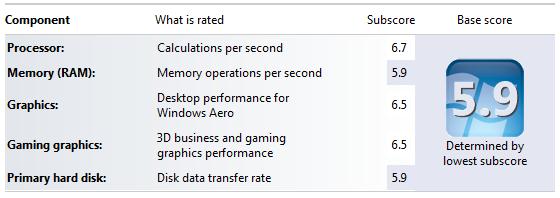
The primary hard disk and the DRAM seem to be slowing down the system. While the DRAM can be overclocked, nothing can probably be done with the primary hard disk (short of replacing it with a SSD). Unfortunately, the Scorpio Black is the fastest 500 GB 2.5" drive in the market right now, and ASRock could probably have not chosen a better drive.
Miscellaneous Performance Metrics
The graphs below give an idea of where the Vision 3D would stand from a performance perspective when compared with some popular notebook computers. PCMark Vantage's PCMark score gives a general idea of the system's capability. In addition to that, a couple of common HTPC workloads are also benchmarked. We have some data on the x264 encoding performance using the Arrandale CPU. An estimate of how well WinRAR performs, particularly with respect to processing split archives, wraps up this section. Since these are CPU-centric benchmarks, it comes as no surprise that the Vision 3D scores better than the
It can be seen from the above benchmarks that the Vision 3D loses out only to its higher clocked and higher core count cousins with respect to CPU-centric benchmarks. There is no doubt, however, that it provides better performance than the mid-range Core 100.
Starting with this review, we will add a WinRAR benchmark for HTPCs. While there is a built-in benchmark to measure the compression speed, it relies on the capabilities of the CPU, DRAM and caches only. Many HTPC users also spend quite some time decompressing split archives. To evaluate this, we take a 4.36 GB MKV file, compress it in the 'Best' compression mode into a split archive (97.1 MB each), which results in 44 files on the hard disk. The time taken to decompress this split archive is then recorded. The performance in this benchmark is heavily influenced by the hard disk in the system. While both the Core 100 and Vision 3D scored similar results in the built-in benchmark (1525 KBps for the Vision 3D and 1452 KBps for the Core 100), the former took 329 seconds to process the split archive, while the latter only took 173 seconds for the same. Starting with the next HTPC review, we will be presenting comparative results for this benchmark in the form of a graph.
In the next couple of sections, we will look at some GPU benchmarks.


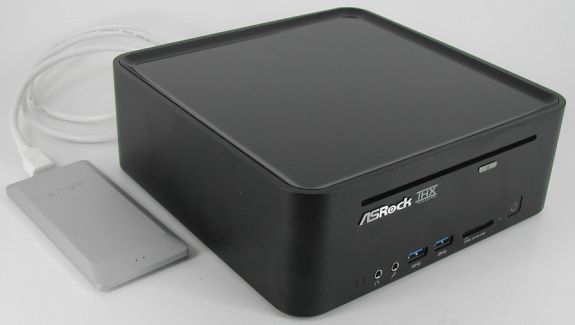
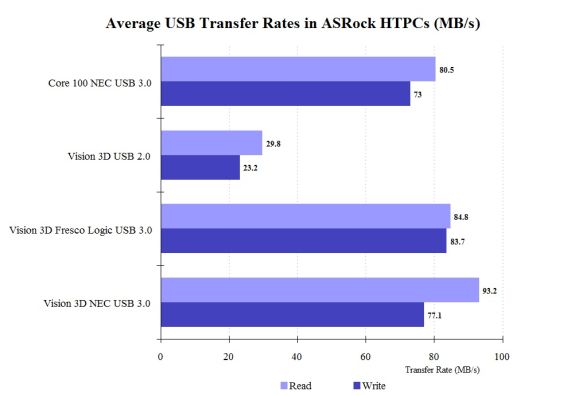
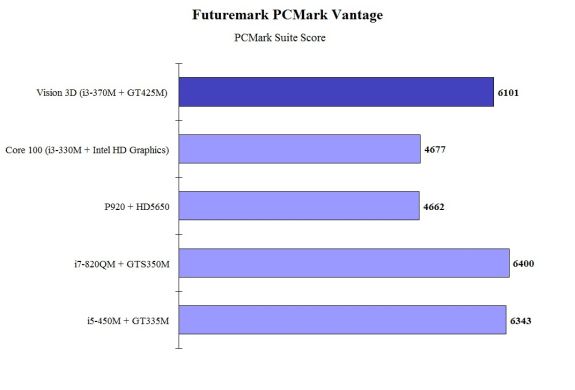
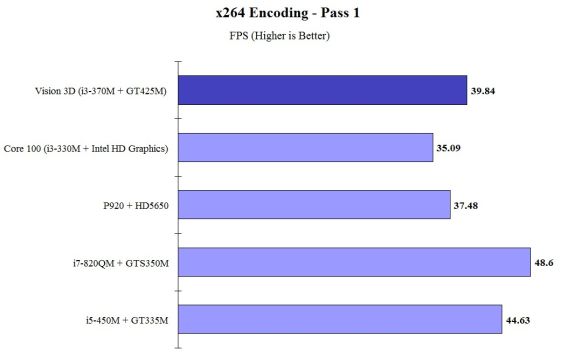
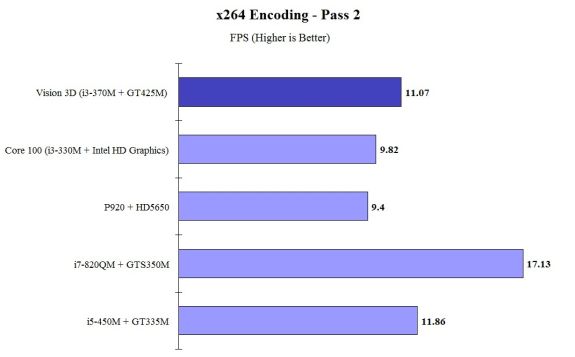








51 Comments
View All Comments
firewall597 - Monday, October 4, 2010 - link
Thats not very fair to say "to me its only worth $---"The product was built with 3D and high end in mind, if this isnt what you need then you shouldn't buy it. Doesnt make it worth any less. There was a fairly accurate breakdown of costs early in the article that laid out how narrow their profit margins could actually be. I would assign this much more value then, say, anything from apple with a similar price tag. If you know what I mean.
If you're only going to need $599's worth of the parts, then buy a lesser box for $599.
andygallo - Monday, October 4, 2010 - link
Everyone has a different experience with drive manufacturers. For me WD has always been reliable. I still run the original 36GB Raptor that I got 5 or 6 years ago and it's still fast as hell and have no issues at all. I have a couple of other WD's that are older than that running great in my storage server. If I were to blanket generalize my experience, however, I would say Seagate and Maxtor are crap.CUDA is NOT CPU+GPU in parallel, CUDA is simply an API that allows GPU computing. The "parallel" in CUDA (Compute Unified Device Architecture) is simply referring to the fact that a GPU is a massively parallel processing unit. What that means is, for certain specific tasks (like HD video encoding/decoding or fluid dynamic models), you can just dump to the GPU for the processing since it is far and away better at running these types of tasks than a traditional CPU. The CPU pretty much does nothing if CUDA is being called.
Also CUDA is NOT supported on AMD/ATI cards, CUDA is specifically for Nvidia. Last I heard, AMD/ATI's solution was called Stream, but I dunno if that's still the case.
From my experience with HTPC builds, Nvidia is definately the way to go. HD video acceleration (DXVA/DXVA2 for Windows or VDPAU for Linux) has MUCH better support on Nvidia cards (VDPAU doesn't even support ATI cards, so if you wanna use XBMC, use a Nvidia card). I've had quite a few h.264 encoded HD videos that couldn't be accelerated on an ATI card that worked flawlessly on an Nvidia. I have yet to see the opposite (and don't get me started on Intel's X4500 "video acceleration"... what a joke). From what I understand that stems from how the video was encoded and that ATI is far less forgiving than Nvidia. Could be a driver issue, but I've seen this disparity since I started playing with h.264 and even today am still able to reproduce the issue (at least 3 years).
humba - Sunday, October 3, 2010 - link
I believe there's one bit missing from the article - a comparison to some of the competing models that could server as a HTCP. I've been using a mini with Win7 and external Blu-ray and I'm very much interested in the Vision 3D. But I'd like to know how it compares in terms of upgrading (Macs are a PITA in that department - especially the 2010 variety - and I'd much rather have a 240GB SSD than a 500GB slow noisemaker), and noise (even under significant load the device stays very quiet).Also.. since this is HDMI 1.4 - can you now drive 2560x1600 over HDMI? Dell claims their 2008 30" model does that resolution over HDMI.. and it sorta works (movies are fine... windows look messed up but I suspect the supposedly dual link capable DVI to HDMI adapter may be at fault)?
Tros - Sunday, October 3, 2010 - link
I am also interested in a comparison. Especially with that kind of price-tag.Also: Is that a newer mac-mini, or and older one? I'd understand the newer one being hard to upgrade, but the older ones not much harder (ifixit.com) than this Vision3d model.
humba - Monday, October 4, 2010 - link
I have the older mini. I agree, it's not that hard to upgrade - however, it's not something for the faint of heart.ganeshts - Sunday, October 3, 2010 - link
As we review more SFF HTPCs, we will present what you want :) We will have the Zino 410 reviewed soon.From HTPC viewpoint, a Mac Mini simply doesn't make sense even though a lot of people use it. There is no HD audio bitstreaming, no native BR drive support. I don't think we ever will reivew a Mac Mini in this space (although Anand reviews them from the general PC perspective, with a section for HTPC).
These PCs from ASRock are primarily targeted towards the DIY market (slowly moving to the layman consumer). As such, they are very easy to upgrade. The HTPC comes with a brochure outlining steps to replace anything and everything you want inside (Even the MXM card!).
Yes, HDMI 1.4a and DVI dual link port can both drive 2560x1600 according to nVidia. We didn't test it out personally, but we have no reason to doubt nV's or ASRock's claims in that department.
humba - Monday, October 4, 2010 - link
Couldn't you just have the software player decode TrueHD / DTS MA to PCM and stream that over the DP / HDMI port? And there's an aftermarket BR upgrade - again not for the faint of heart, but until not so long ago, there weren't any viable alternatives.Aikouka - Monday, October 4, 2010 - link
I didn't even realize that Dell released a new SFF PC for media purposes until I read this article, so naturally, I was curious enough to check it out. I saw the initial price of $299 and was intrigued... is a non-streaming HTPC for a decent price possible? Well, it seems Dell brought my hopes up and subsequently squashed them like a bug. The biggest problem I found with the Zino HD410 is that if you want something decent, it's going to cost you....When I customized the HD410 to an acceptable level, it cost $699. The biggest problems seem to be my need for Windows 7 Professional and the Radeon 5450. I use Windows 7 Professional, because I prefer being able to remote into my HTPCs rather than having to turn the TV on just to make a simple change. Home Premium does not allow incoming RD connections, but does allow outgoing. The issue is that Dell charges $100 to upgrade from Home Premium to Professional... the same "upgrade" on NewEgg is around $40. You also need the 5450 to support bitstreaming, but the only way to get the 5450 is through the higher-end models which start at $499. I also find the requirement of a 500GB HDD in the higher-end models fairly useless... I don't need that much space on the drives and would rather reduce the size to save money.
For that price, I'd probably just consider building a PC using Thermaltake's ElementQ case. It's about the same width (~8" vs ~8.5"), but the Thermaltake case has 5" more depth to it, which shouldn't be an issue in an entertainment center.
Aikouka - Monday, October 4, 2010 - link
Clarification, the customized price on the Dell Zino HD410 is $599, not $699. My bad!Zap - Sunday, October 3, 2010 - link
That "thick copper bar" on the MXM copper plate is a heatpipe. If it really were a "thick copper bar" then it would probably overheat before you finished booting into Windows. Heatpipes do not have to be round.